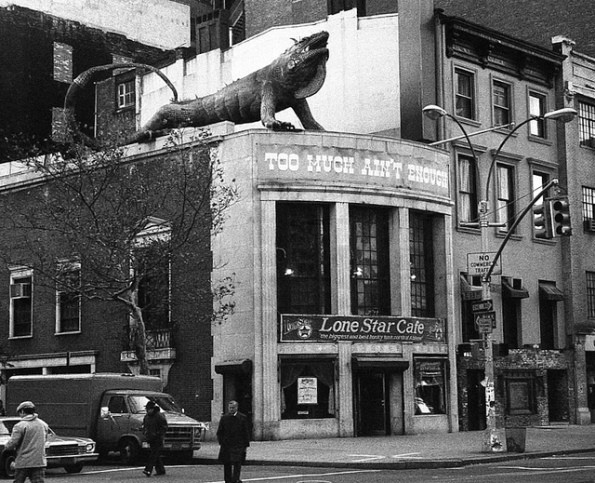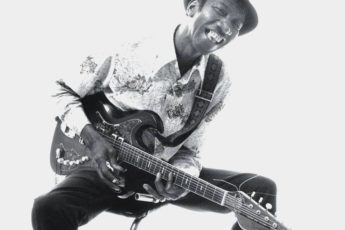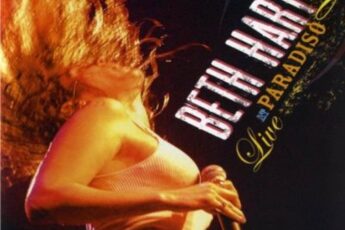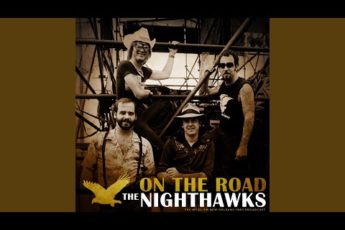
The best live music venue of my lifetime is The Lone Star Cafe, formerly located at the corner of 5th Avenue and 13th Street in New York City. When it closed in 1989, Manhattan music fans lost their only true honky-tonk and blues joint. They also lost a 40-foot iguana. More on that later.
The place with a prominent sign over the main marquee proclaiming “Too Much Ain’t Enough”¹ was a lovable, Texas-themed dive, with a quirky layout wholly inappropriate for a live music club. But it booked the best acts, and really what else matters besides that. If you were sitting at the bar, like I was one night with my friend Cam to see Houston’s Johnny “Clyde” Copeland, you’d be no more than about four body-widths from the stage, close enough to see the sweat pool and then trickle from the scraggly beard of Chicago axe man Son Seals, as I witnessed up close another time (for segments of the show it seemed like he was able to make it drop to the beat). At one end of the stage was a staircase running up to the balcony level, where I stood one evening with my friend Danny to see my favorite band at the time, The Fabulous Thunderbirds, play a tremendous set then have Johnny Winter casually step on stage unintroduced to join their encore. Numerous times with my friend Zing, I also saw eminent blues vocalist Bobby “Blue” Bland, endlessly captivating both for his velvety crooning and for the indescribable phlegm-clearing sound he’d frequently employ to punctuate a line. It was somewhat revolting, frankly (and yes, I had to look up how to spell “phlegm”).
Somehow the two most memorable events to me, though, took place just outside the club, and both coincidentally involved Alberts. One night I was there to see The Ice Man, Albert Collins (alternately known as “The Master of the Telecaster”). I was lined up on the sidewalk waiting for the late show while the early show could be heard taking place inside, when a side door slammed open and Collins burst outside in mid-song. This was before the days of cordless guitars, so he had a roadie furiously feeding out about 40 feet of coiled cord as he literally stopped traffic parading along 13th street and soloing crazily for minutes, with his band still distantly audible inside. An incredible power move. And we still had the whole second show to go.
Then there was the time my friend Skemmit was blatantly shot down attempting his own power move. Skemmit, Zing and I were on our way to The Lone Star to see an all-time great, the man “born under a bad sign”, Albert King. But we couldn’t find parking, and as we repeatedly circled the block, catching the beginning of the show was soon in jeopardy. Exasperated as we pulled past the venue yet again, Skemmit screeched the car to a halt, jumped out to move a pair of pylons from an empty space which were clearly meant to designate use for the band, and slid his beat-up company car up on the sidewalk and into the spot with aplomb. Just as we excitedly exited with high-fives all around, a bouncer resembling the guy at the Dexter Lake Club in Animal House who said “Do you mind if we dance with your dates?” stepped over and asked us what the hell we thought we were doing. Thinking quickly, and somehow with a straight face, Skemmit confidently replied, “Oh, Albert told us it was cool to park here.” The bouncer stared us down and answered sternly, “Wait here.” Which we did, until a minute later when out of the door appeared the man himself, Mr. Albert King. The bouncer looked at us, looked back to Albert, and asked dubiously, “Albert, you tell these white boys they could park here?” King, about 6’5” and 250 lbs. himself, sized us up, reached calmly up to his mouth to remove his ever-present pipe, and uttered, “Uh uh” as he turned to walk away. We were already dashing back into the car by the time the bouncer hollered, “Get that shit outta here!” Eventually we did find a spot, and from just a few feet away saw one of the greatest bluesmen that ever lived play his famous Flying V guitar. He puffed his pipe, and we drank Lonestar longnecks. No hard feelings.
Now back to that iguana. Anyone even vaguely familiar with NYC zoning regulations and restrictions would find it pretty inconceivable now, but somehow the aforementioned 40-foot long, 2,600 lb. sculpture of an iguana, aptly nicknamed Iggy, became a downtown fixture, an icon, living on the roof of the Lone Star where it graced (some would say, disgraced) the otherwise upscale lower 5th Avenue neighborhood (Forbes Magazine headquarters, for instance, was across the street). How it got to be there is a real New York tale. Bob “Daddy-O” Wade was a Texan artist specializing in large installation pieces with a fondness for southwestern kitsch, who’d created the iguana for an art exhibition near Niagara Falls. When that showing ended, he acted impetuously on a friend’s suggestion and called the Lone Star at 2:00AM one morning, where Mort Cooperman, the former club owner, answered the phone so stoned that, he said, it didn’t seem peculiar that a stranger was offering him a giant lizard for the roof. He said, ‘Why not?’ as he recalled, eventually paid Wade a $5,000 fee and another $5,000 in bar privileges, and Iggy had a new home. Before long it became resented by the more conservative local residents and business people who badgered the city for its removal, and at one point the city responded, declaring the iguana to be a sign, and thus subject to size and placement restrictions. But following court hearings, Iggy was instead ruled to be a work of art, not a sign, and thus remained in place. In the mid-’80’s, Lone Star management finally yielded to neighborhood pressure (and conspicuously frequent Fire Department inspections) and removed it from view. But it eventually returned, after Hizzoner, the flamboyant former New York City mayor, Ed Koch, attended a party at the Lone Star one night and remarked that he missed seeing it. In 1989 when the Lone Star Cafe ultimately succumbed to skyrocketing rents and was forced to close, the iguana was sold at auction to a couple who moved it to a farm near Charlottesville, VA. Years later when that couple separated and couldn’t agree on “custody” of Iggy, it was sold back to the original artist Daddy-O, who briefly arranged for it to be stationed again in Manhattan near Pier 25, before it was trucked away for refurbishment to an artist/friend of his in Richmond, where it remained unseen for many years. But one more happy ending awaits: At last report, Iggy has been relocated once again and as of 2010 now resides on the roof of, appropriately, a herpetarium building² in the Fort Worth Zoo. Daddy-O couldn’t have been happier with the resultant homecoming, calling Iggy’s arrival back in Texas “one of the finest moments of my life.” And zoo management, once hesitant to accept the colossal iguana into their modest environs, now enjoy having him sit sentry over the grounds, while their patrons reportedly crowd at his feet and can’t get enough of him. Apparently, too much still ain’t enough.
¹A line plucked from the old Billy Joe Shaver song, “Old Five and Dimers Like Me”
²A zoological exhibition space for reptiles and amphibians
(and here’s video of Iggy’s helicopter transport to the zoo, set to Blue Öyster Cult’s ‘Godzilla’)






Campbell Griffin
August 2, 2018 10:58 amGreat times at the Lone Star. The Ice Man was truly a legendary picker. Saw him do the same outside gig in Houston…was watching Johnny C Copeland at Club Hey Hey. AC was playing across the street at Rockefellers. About half way through JCC’s second set, AC comes waltzing through the door at Club Hey Hey with his guitar, waved to JCC, played a few chords and then strutted back across the street. An unforgettable night!